#dedalus foundation
Text

Robert Motherwell, A la pintura: Black 1-3, (black Japanese paper), Universal Limited Art Editions – ULAE, West Islip, NY, 1968, published 1972 [The Art Institute of Chicago, Chicago, IL. © Dedalus Foundation, Inc./ARS, NY]
#art#collage#drawing#robert motherwell#universal limited art editions#ulae#the art institute of chicago#dedalus foundation#1960s#1970s
423 notes
·
View notes
Photo
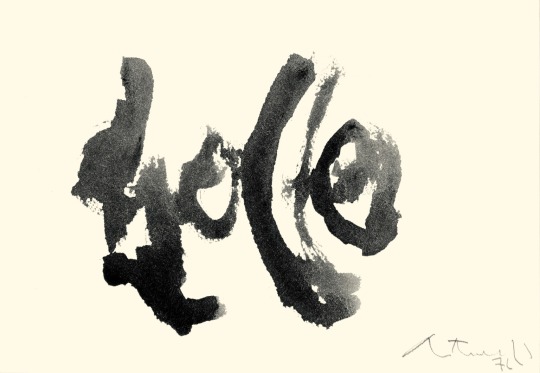
Robert Motherwell, “Untitled” (1976),
Ink on paper, 7 × 10 inches,
Janie C. Lee Collection.
Artwork © 2022 Dedalus Foundation, Inc. / Artists Rights Society (ARS), NY.
Photo courtesy Paul Hester
#art#drawing#painting#abstraction#abstract art#abstract#robert motherwell#ink#forms#dedalus foundation#ARS#paul hester#janie C. lee#1976
38 notes
·
View notes
Text

Robert Motherwell
Wall with Graffiti, 1950, oil and charcoal on linen. Purchase: Gift of Estelle Reninger and Gift of The Dedalus Foundation, 1994. (1994.24)
277 notes
·
View notes
Text

Before he started making chair-like sculptures, Scott Burton made theater-like performance art that centered the public and private physical experience of queerness in the dominant heteronormative culture. His Behavior Tableaux were sets of precisely choreographed movements based on the body language, power dynamics, and covert communication of street cruising.
David Getsy has spent twenty years researching and interviewing to produce the first monograph of Burton's work, which he discussed at Artists Space in Dec. 2023 after the book won an award from the Dedalus Foundation.
#scott burton#david getsy#artists space#performance art#what I want people to become aware of is the emotional nature of the number of inches between them
5 notes
·
View notes
Photo

https://www.siteinspire.com/websites/11323-the-dedalus-foundation
0 notes
Photo

Robert Motherwell, Untitled, 1976. Ink on paper, 7 × 10 inches. Menil / Janie C. Lee Collection, © 2022 Dedalus Foundation, Inc. / Artists Rights Society (ARS), NY. Photo c/o Paul Hester.
0 notes
Photo
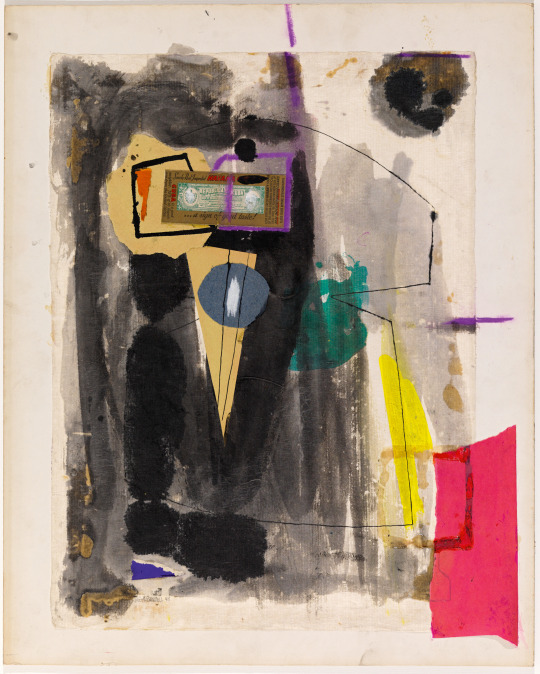
ROBERT MOTHERWELL
UNTITLED
1943
Ink, gouache, watercolor, pastel, pasted colored papers
and printed paper on Japanese paper, mounted on paperboard
#robert motherwell#UNTITLED#1943#inpsiration#Ink#Dedalus Foundation#VAGA#New York#art on tumblr#Galerie Jaeger Bucher#Jeanne Bucher#Paris#Japanese paper#art print#fine art#visual art
29 notes
·
View notes
Photo
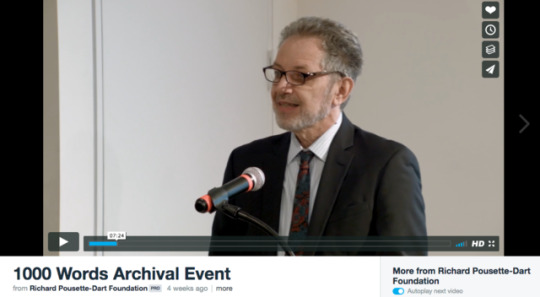
Watch Sanford Hirsch, Executive Director of the Gottlieb Foundation, read from the archive Gottlieb’s speech titled “Unintelligibility," at the Dedalus Foundation’s "1,000 Words: Readings from Independent Artists' Archives."
The speech was originally delivered at the Museum of Modern Art in 1948 as a part of the forum, “The Modern Artist Speaks.”
#adolph gottlieb#gottlieb foundation#painters#art#printmakers#sculptors#video#art talks#artist grants#dedalus foundation#robert motherwell#richard pousette-dart#gottlieb#archive#history#art history#art theory#aesthetics#new york#abstract expressionism#modernism#modern art
2 notes
·
View notes
Text
So I needed to take a break from this digital painting--so i decided to redesign Danny Fenton and write out a lil' drabble on it because I wanna make my own fanon more complicated.
Taking a break from art by doing more art sounds stupid but I swear it's not. I promise.
Danny Fenton was sorta' familiar with the kinda' tedious process that was a Fenton-Hazmat.
It was annoying to put on, but he did it for curiousity's sake. And because of that same curiousity, he visited the lab a lot.
Take off the weathered shoes and baggy jeans, slide on the white rubbery jumpsuit, give up a sample of blood to the computer and put on the dark maneoprene gloves which always felt weird. Hot and cold at the same time almost. It was apperently an "artificial ecto-insulator that prevented ecto-contamination."
Then you would put on the mask--maneoprene too--and plug it into the computer, enter your BPM, eye color and a password to unlock the suit. You couldn't take anything but the mask off if you tried.
After that, you walk through the sci-fi doors and get sprayed by a gajillion water particles. It was really only annoying because it either sprayed you with too much force and you'd get knocked over and the motion detectors would keep registering you so it kept spraying or you'd be taken by surprise because the sensors glitch and you'd be caught off guard by the gajillion water particles.
Or both. In the order listed, but in reverse.
It usually only happened to Jack and Danny.
Now, it seemed trivial as Jack Fenton held the plugs almost reverently, Maddie Fenton--his wife and Danny's Mom--on standby as they stood at the edge of the warning border like Icarus and Dedalus with their metal wings.
The Ghost Zone portal, it was supposed to pierce a hole through two dimensions.
Ours, and the ghosts.
It was their biggest project yet, the culmination of years and years of work.
Jazz--Jasmine--stood next to him, waiting for what she thought another failure. Her Hazmat was the same color as their Mom's--albeit a little more vibrant. It set off a nice contrast with her neon-orange-hair.
A swift movement--his Dad plugging it in-- and a spark as it revved up, the whirring of electricity was clearly audible now, until...
Nothing.
It all powered down and Jazz's scoff seemed to higlight it. She always did have a bit of disdain for this stuff.
Her blue eyes softened though, as their parents seemed to sag and wilt and lose all energy.
Dad--with a feverent desperation--unplugged it and plugged it again.
And again.
And again.
Nothing. Not a lick.
"I--I suppose we'll need to work on it more, Maddie!" Jack smiled at them--and it was scary because this wasn't the overwhelming bravado that their father always seemed to exude.
It was wrong.
The two scientists awkardly shuffled past.
"So it didn't work?" Tucker Foley asked, his hat off as if paying his respects.
"No, my parents seemed so..."
"Gloomy? Depressed? Overwhelmingly Sad? As if they had lost all of their luster and determination like a fire ravaged their soul?" Sam Manson asked, tilting her head and jostling her dark-as-night hair.
"Uh, yeah. That."
The girl nodded, seeming satisfied as she chomped on a vegan burger.
Tucker put his beret back on his head and asked, "why don't you go fix it? Your Dad 'blathers on' about this stuff enough right?"
"Yeah... Not... Not today though."
"Woah, that sounds unreal."
Sam suddenly stood up, "so we're fixing it?"
"I don't really know that much. I only know some basic stuff--like how in possesion, your heartbeat slows down or that ghosts are like a snapshot of their wants--kinda like a combination of... What was that egyptian thing? Ba and Sheut, two parts of the soul? and that they're not sentient." He shrugged. "Y' know, basic stuff."
And it really was. When their parent's taught them Ectology, they had no foundation to stand upon because as they were wont to do, got caught up in ecto-conductive polymers and the practical applications of theoretical quantum physics in Ectology and the philosophies on souls--they forgot one damn thing.
To hand out the building blocks.
"'Shit?'" Sam asked, teasing.
"Sheut." Tucker defended.
"Meh."
Sam turned away from Tucker and polished off her burger, staring right at Danny. "But you want to fix it."
I sagged. "Yeah."
"Then how about we all just check it out? Finally wear those custom hazmats your parents got us."
Danny still looked a bit unsure, but it seemed to disappear from view, relplaced by a determined ice-cold stare.
Sam's Hazmat suit was a dark purple and she liked it, though, she thought it could use some modification to look more cybergoth.
Tucker's was a Day-Glo yellow that you could see from miles away.
Danny's was snow-white. Tucker questioned this. "Your favorite color's blue, isn't it?"
He looked away, embarassed, and they--Sam and Tucker--knew it was gonna be good.
"It... It looks sorta' like a sci-fi space suit."
The two burst out laughing--it wasn't particularly funny, and in hindsight seemed more obvious than not but, it lightened the mood. And Danny seemed to need it.
The boy smiled at them as they passed throught the door, the shower activating and drenching the suits.
Then they walked up to the portal, was it bigger?
"Woah, this is neat. Straight outta STARGATE. Is this a Stargate, Danny?"
Danny chuckled at Tucker--though now that he faced the Ghost Zone portal, it was harder--"nope."
Then he shrugged, "close though."
"So...why don't you go in, Danny?" Just to see. Check it over." Sam urged, a tiny encouraging smile on her face. She was really trying.
"Yeah... who knows what awesome stuff is in there," Tucker said, he had taken to wearing the mask as a beanie, while Sam left her's off.
Danny did too.
(Sometimes he wonders if this wouldn't be what this was if he had just kept that stupid thing on--would he be an Astronaut? Some other cool space related job, looking at the stars instead of bloodying his fists--was it blood?--everyday--tired and on the verge of burning out--would he have not had to stare in to that man's eyes as he died, staining his face red and plaguing his thoughts forever? He wished Clockwork would tell him. Or not. Maybe it was for the better he didn't know.)
He walked to the mouth, it was like a gaping maw--the mouth of a monster--or a cave's entance. It was dark in there, as if it was sucking up all the light.
He went in.
He stumbled.
He heard a beep. Then a crackle.
Electricity.
The next thing he knew, his life changed as a ghostly wail tore itself from his throat.
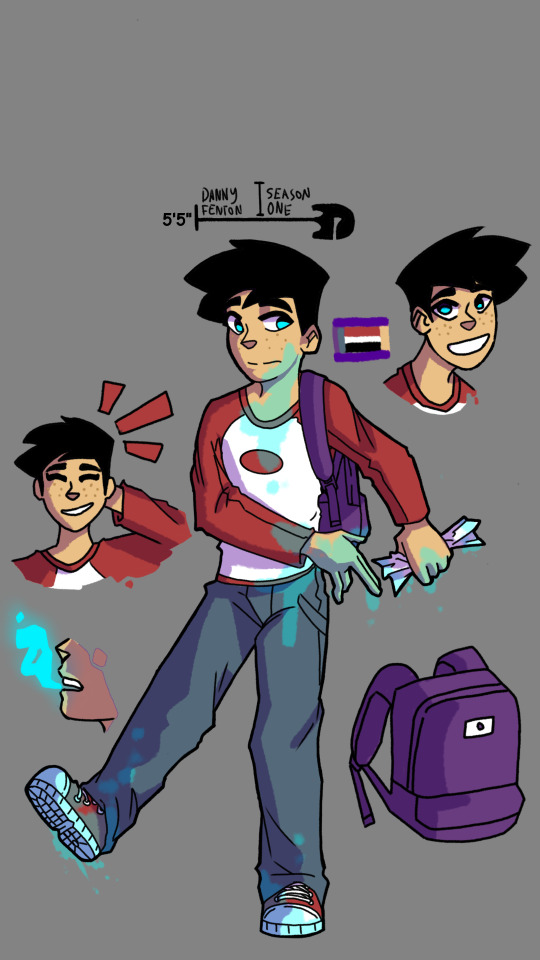


Was that cool? I don't know. It was fun though.
Anyway, more word vomit!
So for his civies, I didn't really want to change much except to make his shirt long-sleeved. There really wasn't much change there. The reason he's drenched is because Dash is a dick.
Now for the Hazmat, i never really wanted to change much besides making it a lot more floofy and baggy and loose. Since this is a Hazmat. The treadless shoes are both a pun for a very specific situation and also because I read a Hardy Boys book when I was 11 and they had these shoes without any sort of treads to prevent contamination.
I don't know if it's true at all. But it was in a book. So it must have been(sarcastic).
I also didn't want to draw them except I did so I have no excuse.
The process for the colors was pretty straightforward. I just inverted them. And made the red a little redder. And the ectoplasm a lttle bluer. Cuz inverted, it's a nice bright red burgundy.
Manesoprene is from Manes and Isoprene. Manes being the souls of their dead, and Isoprene as in it's polymer which is the main component of natural rubber. The doorway/washing station shower thing just seemed to make sense.
#art#digital art#danny phantom#concept art#danny fenton#danny phantom fanart#danny phantom phanart#the pun is#:THOSE WHO TREAD HERE SHALL FADE!#DP: Oh#okay then#I'm safe#:NO#DP: Yeah I am! I have no treads!#*holds up foot*#sam manson#tucker foley#jazz fenton#maddie fenton#jack fenton#danny phantom fanfiction#sam and tucker would facepalm so hard they'd join danny in the half-ter life#i am on FIRE today#fanfiction#drabble#headfanon#writing#doc's art
210 notes
·
View notes
Text

Elegy to the Spanish Republic (1958–61) by Robert Motherwell (Philadelphia Museum of Art: 125th Anniversary Acquisition. Gift (by exchange) of Miss Anna Warren Ingersoll and partial gift of the Dedalus Foundation, Inc., 1998-156-1) © Dedalus Foundation, Inc. / Licensed by VAGA at Artists Rights Society (ARS), New York
Seeking an outlet to express his feelings of "abandonment, desperation, and helplessness” in the wake of a divorce, Robert Motherwell began a decades-long project about the demise of Spain's Second Republic in the Spanish Civil War (1936–39), which marked the collapse of democracy and the onset of widespread suffering in that country. Monumental in terms of both size and emotion, this work often elicits interpretations about the relationship(s) between death and life, because the dark and light sections exist in complex dialogue, particularly evident in the areas of overpainting where gray “shadows” encircle the black ovals, serving as enduring remnants of once-larger forms.
7 notes
·
View notes
Text

Robert Motherwell, The Aberdeen Stone, (color lithograph on light gray wove paper), Universal Limited Art Editions – ULAE, West Islip, NY, 1971 [The Art Institute of Chicago, Chicago, IL. © Dedalus Foundation, Inc./ARS, NY]
#art#drawing#visual writing#lithograph#robert motherwell#universal limited art editions#ulae#the art institute of chicago#dedalus foundation#1970s
96 notes
·
View notes
Photo

Elegy Sketch, Robert Motherwell, 1977, MoMA: Drawings and Prints
The Riva Castleman Endowment Fund and Gift of the Dedalus Foundation
Size: composition: 5 1/16 × 12 5/8" (12.9 × 32.1 cm); sheet: 9 1/16 × 23 15/16" (23 × 60.8 cm)
Medium: Lithograph
http://www.moma.org/collection/works/60795
4 notes
·
View notes
Text
3. Interview with Asianish
An interview with Sara Jimenez, Maia Cruz Palileo, Gabriel de Guzman and Cecile Chong, co-founders of Asianish. Part of our series of interviews with affinity spaces and groups.

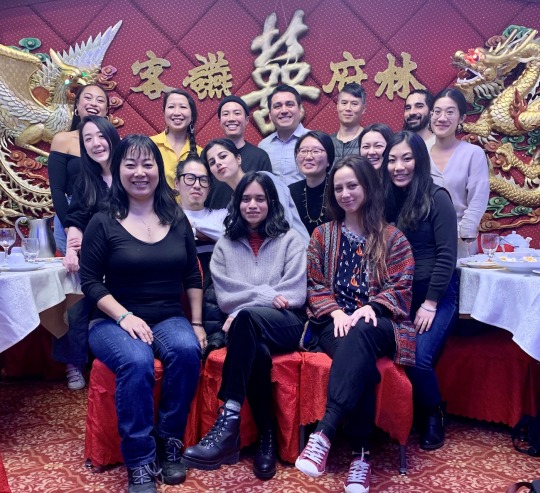
Correspondence Archive (CA):
Can you please tell us a bit about your group?
Asianish:
A few of us, including artists Sara Jimenez, Maia Cruz Palileo, Cecile Chong and curator Gabriel de Guzman, were interested in informally sharing and discussing the nuanced complex iterations of Asian/South/Southeast/East Asian/etc identifying individuals in NYC. We are interested in holding space for these “Asian-ish” hybridized identities that sometimes overlap and are also incredibly unique and specific to each individual.
The idea for these gatherings came out of our experience after participating in the NYC Creative Salon in March 2018, around the theme “identity.” That particular discussion was so rich that when it ended, we knew that we needed to do it again because there was a deep desire and an urgency to share intimate, non-white space together, what has come to be called Asian-ish.
We are grateful that this community exists. It seems at the root all of our discussions has been the need and desire to come together to identify the various ways in which we are affected by and wish to fight against the white supremacist structures of power. We hope that this community that we’ve built can continue to grow and recognize each other as resources for growth, strength and wisdom.
CA:
From what I understand your group meets regularly for discussions and presentations. Do you do any other projects like pop-up exhibitions or public facing programming or have plans to do so in the future?
Asianish:
Since March 2018 we met every few months in person and every time we had a different topic of discussion - identity, home, embodiment, community, food, nature. We also had a one day community celebration at the Dedalus Foundation with the Sunset Park community with performances, hands on activities and slide presentations. At the beginning of Covid we started to meet via Zoom, then our meetings became weekly when we felt the urgency to center our discussion around Asian solidarity with Black Lives Matter. In the future we may think about having public facing programming hopefully when we can meet in person.
CA:
Why was it important to you to intentionally form your organization as an affinity group? What specifically did you feel was missing that needed to be addressed by your group?
Asianish:
There were no spaces in the NYC art scene that had a contemporary lens for artists who identify as being in some kind of multiplicity in an Asian identity. We wanted to create a space that was not just for scattered pocket conversations but having it be a community. We felt that it was missing and that was what brought us together.
CA:
What can an affinity group do that a mixed/blended group cannot? What is the unique work that your organization can do?
Asianish:
Our conversations are centered around being POC. We felt the need to create a space for BIPOC to get together in the room and to be able to talk about things in a completely different way. The conversations are able to go in directions that typically in a mixed blended group the discussion can become limited. We recognize the inherent power structures that tend to exist in a room, whether it is intentional, conscious or subconscious. There are power structures and privileges that tend to take up space. Our discussions in a way function to upset this power imbalance. We want to let these conversations exist without the presence of these judgments or opinions which make it harder for BIPOC to express how we feel.
CA:
What are the limitations of an affinity group? Is there something a mixed/blended group can do that an affinity group cannot?
Asianish:
The fact is that mixed/blended groups tend to have more economic power and can raise more money. Because of this system of privilege that exists maybe an affinity group can tap into that privilege. As an affinity group we may not have that much access to privilege versus wealthier mixed/ blended members.

CA:
What has surprised you about being involved in your group? What are some of the unforeseen impacts it has had on you personally and on the community/ies you are serving?
Asianish:
There are many of us (96 participants and we keep growing.) We are surprised that so many are creating this space and how large our community actually is. On one hand we’re tied in together as Asianish, on another hand we’re very mixed and blended. The framework of the questions here could challenge that we do and we do not center around whiteness. Our discussions are about complicating that kind of binary, even though many of us are of partial white descent.
We’re also surprised that at one point we wondered who would be willing to meet and do all the work and planning? But there has been much to talk about and enough people to meet every week. It has been wonderful and surprising of the kind of support that is there.
CA:
How do you view your and your group’s role in relationship to the larger, WSCP art world? For me, assimilation seems both impossible and problematic, while trying to force it to change is exhausting and depressing.
Asianish:
Theaster Gates comes to mind who used the financial capital system and bought a building in Chicago to create opportunities for his community. It is about learning how to work with the existing structures in order to create change.
Recently we’ve had discussions of perhaps not moving towards utopia, but instead being in this inherent contradiction of a system and realizing that big money means blood money. We question how we can navigate within that conflict in an ethical, accountable way. Even if that means naming it and continually participating in a very mindful, collective and active way. Perhaps we can shift our perspectives and attitudes and think that there’s no utopic way or a simple answer. Instead we can see it as a daily struggle to grapple with and continue to have conversations to try to understand and unpack.
In our conversations we also find ourselves sharing with each other about after the trauma of our education system and many of us being in and part of the education system now, and how we’re still surrounded with white supremacy capitalism patriarchy. We’re having a place to come together to share those experiences. A big part of what we want is to create a visual culture that we want to see, one that makes more sense of our experience to our world.
CA:
Shout outs! Who are the groups (contemporary or historical) that you look to for inspiration and that you are excited about?
Asianish:
We admire organizations that support black artists like MOCADA and the Studio Museum, and also organizations that support Latinx and Caribbean artists. In the past there was Godzilla Collective but now besides A4 we don’t see organizations that support Asian or Asianish artists. We admire Asian American Writers’ Workshop, and we love Kundiman!
CA:
How can people support Asianish? Does Asianish have any social media accounts that we can follow?
By being a guest speaker in our meetings. You can follow #asianishsolidarity on IG.

Asianish is a common space for people of Asian descent working in the field of visual art. We acknowledge the multi-racial, multi-ethnic identities shared and honor and respect our intersections. We are interested in holding space for these hybridized identities that sometimes overlap and are also incredibly unique and specific to each individual. By sharing our practices, we intend to deepen our connections individually and collectively so that we may strengthen and support our community within and beyond Asianish.
1 note
·
View note
Text
Introducing | 2020 Canadian Women Artists’ Award Recipients Destinie Adelakun and Sara Jimenez
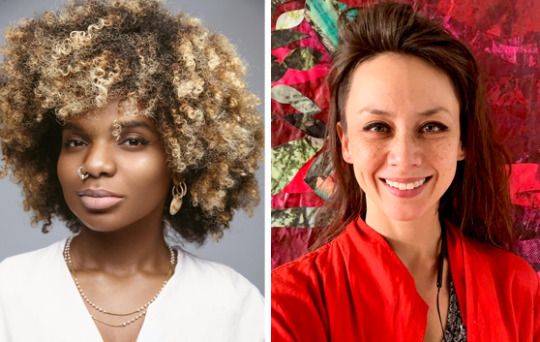
The Canadian Women Artists’ Award is offered by NYFA with funding from the Canadian Women’s Club of New York.
The New York Foundation for the Arts (NYFA) has announced interdisciplinary artists Destinie Adelakun and Sara Jimenez as its 2020 Canadian Women Artists’ Award recipients. The $5,000 award is designed to provide financial support to women-identifying emerging or early career artists working in any discipline, and can be used in any manner the recipient deems necessary to further their artistic goals. The award program is supported by funding granted to NYFA by the Canadian Women's Club (CWC) of New York as a way to continue its philanthropic work when it disbanded. This year, in response to the impact of the COVID-19 pandemic on the creative community, the CWC and NYFA decided to award two prizes.
“We’re proud to partner with the Canadian Women’s Club to offer this award, and are especially grateful to recognize not one but two artists,” said Michael L. Royce, Executive Director, NYFA. “Destinie Adelakun and Sara Jimenez are exceptionally talented cross-disciplinary artists, and we are excited to hear more from them as they continue to push their careers forward,” he added.

Destinie Adelakun is a Lagos, Nigeria-born, Nagpur, India-raised Canadian artist whose work extends from mixed-media, painting, and photography to film and sculpture, and explores topics ranging from African history, mythology, and spirituality. She utilizes individuals in her work as a personification of principles and ideas, and a way to re-illustrate African and Indian mythological tales. Adelakun, who received a BFA degree in Fashion Production from The London College of Fashion, celebrates women of the African diaspora and plays with the adornment that embodies the creative direction of the work. She has collaborated with noted art world icons such as Renee Cox, Mickalene Thomas, and Taha Clayton to name a few, and curated several art shows in the New York region before recently transitioning to showing her own art and photography work. She currently lives and works in New York, NY.
Said Adelakun upon receiving a 2020 Canadian Women Artists’ Award: "As a biracial daughter of the diaspora, life has thrown countless battles on my path to success. I recently became a mother during this global pandemic, and just when I felt overwhelmed and buried by the challenges of life I received this ray of opportunity. This award means that I have the opportunity to continue to create work. It is an opportunity for me to allow other young women of color, especially mothers, to see that creativity and achievement doesn't end after childbirth. This award and its recognition will elevate my career to a whole new level, and it's an affirmation to continue working and believing in myself."

Sara Jimenez explores the material embodiment of deep transcultural memories. As an interdisciplinary Filipinx-Canadian artist, she is interested in materializing existing global narratives around concepts of origins and home, loss and absence. She works in collage, sculpture, installation, and performance to create visual metaphors that allude to mythical environments and forgotten artifacts. Jimenez is a collector and alchemist: among other things, she collects familial narratives, abandoned objects, debris, compost, colonial texts and photos, maps, and textiles. Through material experimentation, she combines and rearranges elements from her collections to complicate pre-existing narratives of place, lineage, and temporality. Her work has been exhibited at the Pinto Art Museum (Philippines), El Museo del Barrio, Brooklyn Museum, and others, and she has performed at numerous venues including The Dedalus Foundation, The Noguchi Museum, and Dixon Place. Upcoming, Jimenez will have solo shows at Irvine Fine Arts Center and The Center for Chinese Contemporary Art in Manchester, England, and will participate in the 2021 Cornell Biennial curated by Tim Murray. Jimenez received her BA degree from the University of Toronto and her MFA degree from Parsons the New School for Design. She teaches at Parsons, New York University, and Borough of Manhattan Community College and mentors graduate students at the Vermont College of Fine Art and School of Visual Arts. Jimenez is based in Brooklyn, NY.
Said Jimenez upon receiving a 2020 Canadian Women Artists’ Award: "I am incredibly honored to receive this award. It is humbling and moving to be gifted resources to pursue my vision and share it with the world. I want my work to be of service to the public and to shift the paradigm of visual culture."
Lorraine Bell, Board Director Bridgemarq Real Estate Services, Hot Docs Foundation USA, the University of Toronto Associates, Inc., and former Canadian Women’s Club member, spoke about the rationale behind giving two awards in 2020: "I know the financial struggles that artists face during the best of times can be difficult, but layer a global pandemic onto that and it can be overwhelming. So the decision to award two worthy Canadian recipients in 2020 was made and we are thrilled with the selections of artists Adelakun and Jimenez."
Find out about additional awards and grants here. Sign up for our free bi-weekly newsletter NYFA News to receive announcements about future NYFA events and programs.
Images from top: Destinie Adelakun and Sara Jimenez, Photo Credits: Sheridon Poyer and Sara Jimenez; Destinie Adelakun, ADE - Oshun and Oya's crown, 2020; and Sara Jimenez, Cenotaph, 2018
#announcements#instagram#canadian women artists award#canadianwomenartistsaward#destinieadelakun#destinie adelakun#sara jimenez#sarajimenez#canadian artist#canadianartist#artist award#artistaward#cwc#canadian womens club#canadianwomensclub#canadian women artists#canadianwomenartists
7 notes
·
View notes
Text
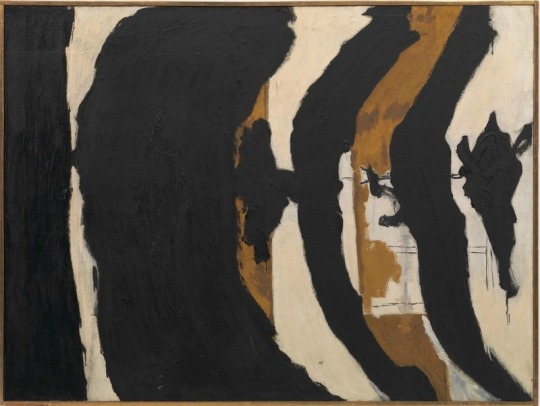
Robert Motherwell, Wall Painting No. III, 1953. Oil on canvas, 137.1 x 184.5 cm. Private collection. Courtesy Hauser & Wirth © Dedalus Foundation, Inc. /VAGA, NY/VEGAP, Bilbao, 2016
Courtesy Alain Truong
4 notes
·
View notes
Photo

Robert Motherwell (1915–1991), Untitled, 1958. Mixed media collage on paper, 14 1/4 x 11 1/4 in. (36.2 x 28.6 cm). Grey Art Gallery, New York University Art Collection. Anonymous gift, 1964.60. © Dedalus Foundation, Inc. Licensed by VAGA, New York, NY
#robert motherwell#untitled#1958#1950s#mixed media#collage#abstract#abstract expressionism#Helen Frankenthaler
5 notes
·
View notes